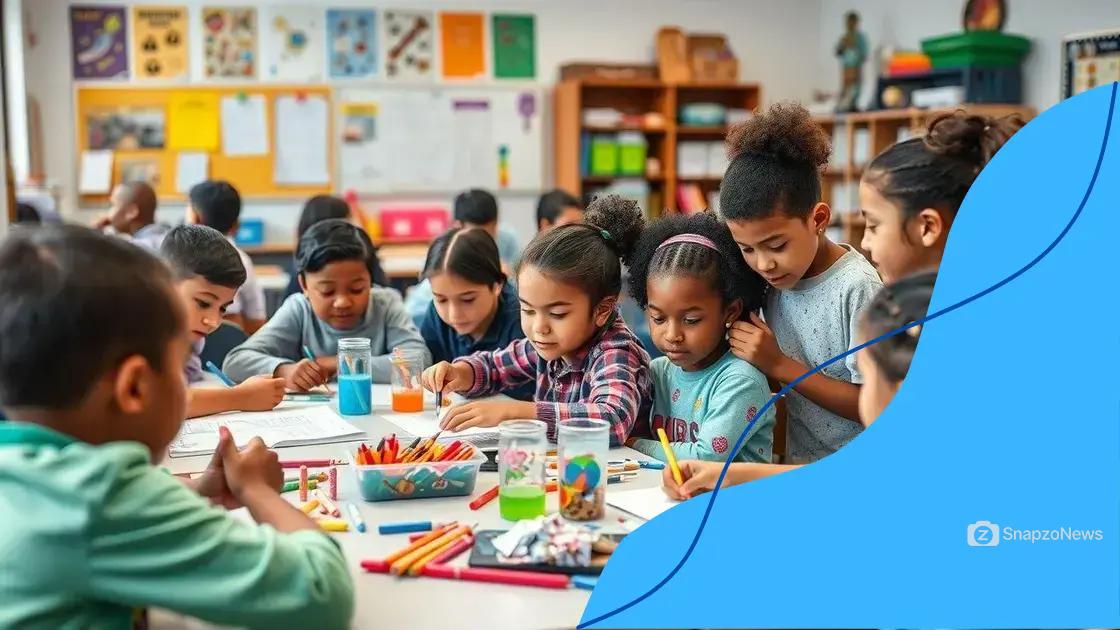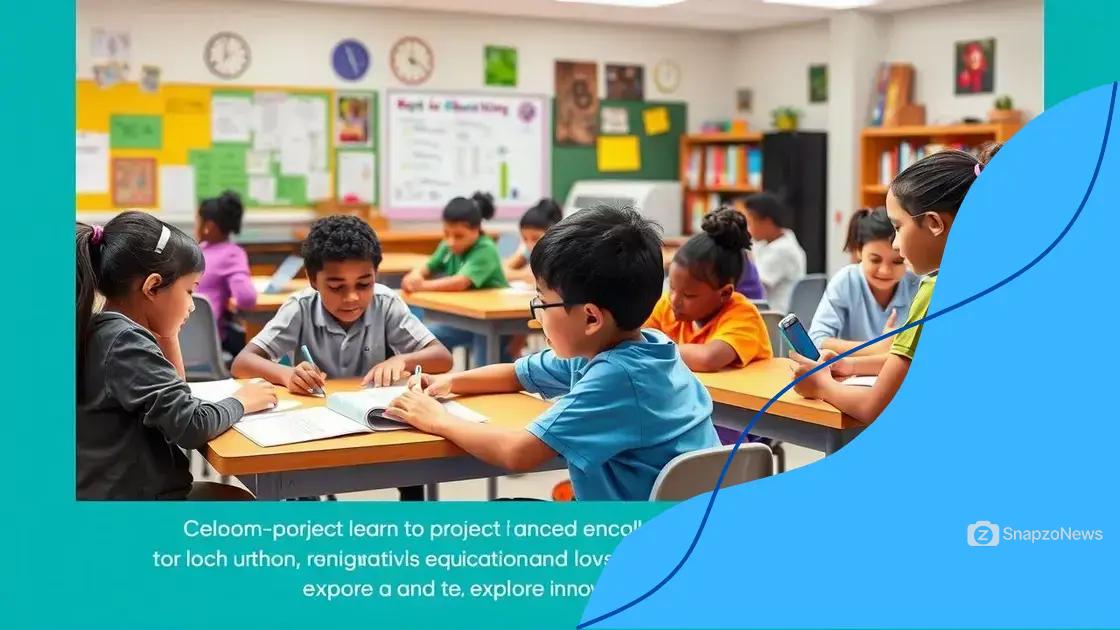Cultivating creativity and innovation in education

Cultivating creativity and innovation in education involves fostering collaboration among students, integrating technology, and implementing engaging teaching strategies that promote critical thinking and problem-solving skills.
Cultivating creativity and innovation in education is essential for engaging students and preparing them for the future. Have you noticed how a creative approach can transform the learning experience? Let’s dive into strategies that inspire both teachers and students.
The importance of creativity in education
Understanding the importance of creativity in education can transform the way students learn and engage. Creativity allows students to express themselves and develop critical thinking skills. It opens the door to new ideas and encourages deeper understanding of subjects.
Enhancing Problem-Solving Skills
One of the key benefits of creativity in education is that it enhances students’ problem-solving abilities. When students are encouraged to think outside the box, they learn to approach challenges from different angles. This skill is not just important in school; it prepares them for real-world situations.
Building Emotional Intelligence
Creativity fosters emotional intelligence by allowing students to explore their feelings and the feelings of others. By engaging in creative tasks, students can learn empathy and collaboration. These skills are crucial for social interactions both in and out of the classroom.
Ways to Incorporate Creativity
- Integrate arts into the curriculum.
- Encourage group projects that require creative thinking.
- Use technology to enhance creative learning experiences.
- Create a classroom environment that promotes experimentation.
Furthermore, when educators embrace creativity, they can make learning more enjoyable and relevant. This enjoyment often leads to improved academic performance. Students are more likely to participate in lessons that resonate with their interests.
Another critical aspect is that creativity helps in developing resilience. Students learn that making mistakes is part of the creative process. This understanding encourages a growth mindset, where they view challenges as opportunities for learning.
Finally, when creativity is part of the educational experience, it helps prepare students for future careers. Many modern jobs require innovation and the ability to think creatively. By fostering these skills early on, educators can equip students for success in a rapidly changing world.
Techniques to foster innovation in the classroom
Exploring techniques to foster innovation in the classroom is essential for creating an engaging learning environment. Innovative teaching practices can inspire students and help them develop the skills they need for the future.
Encouraging Hands-On Learning
One effective technique is to incorporate hands-on learning activities. Allowing students to work on projects or experiments can enhance their understanding of concepts. This approach not only engages them but also promotes critical thinking.
Implementing Technology
Integrating technology in lessons can significantly boost innovation. Using tools like interactive whiteboards, educational apps, and online collaboration platforms can make learning more exciting. Students often respond positively to technology, which can lead to increased participation.
Creating a Safe Space for Ideas
Another important technique is establishing a classroom environment where students feel safe to share their ideas. When they know that their contributions will be valued, they are more likely to express their thoughts creatively. Encouraging open discussions can lead to innovative solutions and collaborative projects.
- Use brainstorming sessions to generate new ideas.
- Encourage student-led presentations on topics of interest.
- Create flexible seating arrangements to promote teamwork.
- Host innovation challenges or competitions.
Moreover, allowing for student choice in projects can drive innovation. When students can select topics that resonate with them, they are generally more motivated and creative. This sense of autonomy helps them take ownership of their learning process.
Lastly, professional development for educators is crucial. Providing teachers with resources and training on innovative teaching strategies can empower them to implement new ideas in the classroom. Continuous learning for educators translates directly to enhanced learning experiences for students.
Real-world examples of innovative education

Throughout various educational settings, there are numerous real-world examples of innovative education that demonstrate effective teaching practices. These examples show how creativity and new approaches can reshape learning experiences for students.
Project-Based Learning
One notable method is project-based learning, where students engage in projects that require critical thinking and collaboration. In this approach, students often work on real-life problems, which makes their learning more relevant and engaging. For example, a class may work on a community project, like designing a local park.
Flipped Classroom Models
Another innovative approach is the flipped classroom model. In this setup, students first explore new content at home, often through videos, and then come to class to apply what they’ve learned through discussions or activities. This method fosters a deeper understanding of the material and increases class engagement.
Personalized Learning Plans
Many educators now implement personalized learning plans that cater to the individual needs of each student. These plans allow students to progress at their own pace. For instance, students might use adaptive software that adjusts the difficulty based on their performance, ensuring that they are continually challenged but not overwhelmed.
Collaboration with Local Organizations
Innovative schools often collaborate with local community organizations to enhance learning experiences. For example, a school might partner with a local museum to create student projects based on current exhibitions. Such partnerships enrich the curriculum and provide students with unique insights and practical experiences.
- Using technology to connect with experts worldwide.
- Creating mentorship programs with community leaders.
- Incorporating service learning that connects education to social issues.
Through these methods, students gain not only knowledge but also valuable skills that prepare them for their future. By observing and learning from these real-world examples, educators can adopt practices that promote innovation and creativity in their own classrooms.
Role of technology in creative learning
The role of technology in creative learning has become increasingly significant in modern education. Technology not only enhances traditional teaching methods but also opens new avenues for creativity and innovation among students.
Interactive Learning Tools
One way technology contributes is through interactive learning tools. Applications and software that allow students to engage through quizzes, games, and simulations can make learning more dynamic. For instance, virtual reality (VR) can transport students to different environments, offering immersive experiences that deepen understanding.
Collaborative Platforms
Another crucial aspect is the rise of collaborative platforms, which enable students to work together regardless of their physical location. Tools like Google Classroom and Microsoft Teams facilitate group projects, allowing students to brainstorm ideas, share resources, and provide feedback in real time. This collaboration encourages creativity and fosters teamwork.
Access to Online Resources
Additionally, technology grants students access to a wealth of online resources. They can explore educational videos, podcasts, and articles that expand their knowledge beyond what is taught in the classroom. This exposure can spark new ideas and encourage independent research.
- Utilizing coding programs to develop problem-solving skills.
- Incorporating digital art tools for creative expression.
- Engaging students with multimedia presentations.
Moreover, technology allows for personalized learning experiences. Students can learn at their own pace through adaptive learning systems that adjust to their individual needs. This flexibility not only supports diverse learning styles but also encourages innovation as students explore topics that interest them.
In bringing creativity into the classroom, educators can use technology to facilitate workshops, host hackathons, or integrate maker spaces. These initiatives can inspire students to experiment and invent, making learning both fun and impactful.
Encouraging collaboration among students
Encouraging collaboration among students is essential for fostering creativity and innovation in the classroom. When students work together, they can share diverse ideas and learn from each other, leading to a richer educational experience.
Group Projects
One effective way to promote collaboration is through group projects. Assigning tasks that require teamwork allows students to combine their strengths. For example, in a science project, students might divide roles based on their interests, such as researcher, presenter, or designer. This approach not only builds skills but also enhances relationships among peers.
Peer Feedback
Implementing peer feedback sessions is another excellent strategy. When students provide constructive feedback on each other’s work, they develop critical thinking and communication skills. This practice encourages students to articulate their thoughts and helps them appreciate different perspectives.
Collaborative Technologies
Using collaborative technologies can also enhance teamwork. Platforms like Google Docs or Padlet allow students to work together in real-time, regardless of location. These tools can make group work more efficient and engaging, as students can share ideas and resources seamlessly.
- Organize group discussions to brainstorm solutions.
- Introduce problem-solving challenges that require teamwork.
- Encourage students to teach each other new concepts.
Furthermore, creating a classroom culture that values collaboration is vital. Teachers can model collaborative behavior by showing how to work with others effectively. When educators emphasize the importance of teamwork, students are more likely to develop these skills themselves.
Lastly, rewarding collaborative efforts can motivate students to engage more fully with their teams. Recognizing group achievements publicly fosters a sense of community and encourages other students to participate actively in collaborative activities.
In summary, fostering creativity and innovation in education is vital for preparing students for the future. By encouraging collaboration among students, using technology effectively, and providing engaging learning experiences, educators can help students develop the skills they need to succeed. As we embrace these strategies, we can create a more dynamic and supportive educational environment where every student can thrive and explore their full potential.
FAQ – Frequently Asked Questions about Creativity and Innovation in Education
Why is collaboration important in the classroom?
Collaboration helps students develop teamwork and critical thinking skills, leading to a more engaging and enriched learning experience.
How does technology enhance creative learning?
Technology provides interactive tools that facilitate engagement, collaboration, and access to a wide range of resources for students.
What are some effective techniques for fostering innovation?
Techniques like project-based learning, peer feedback, and the use of collaborative platforms can significantly enhance innovation in education.
How can teachers create a culture of creativity?
Teachers can promote creativity by encouraging idea sharing, providing a safe environment, and recognizing collaborative efforts among students.
